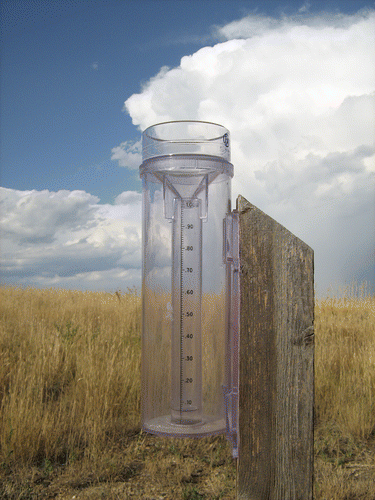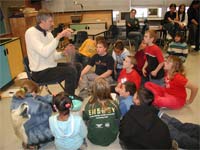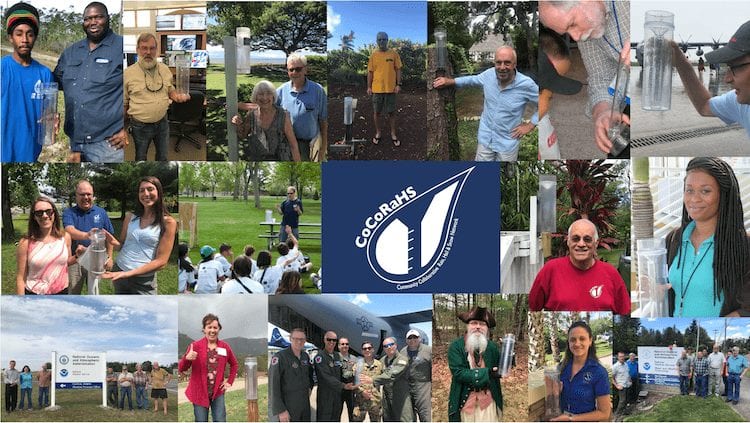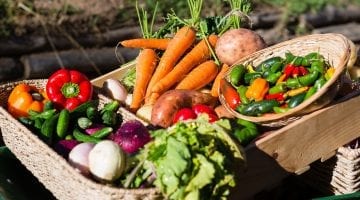The Community Collaborative Rain, Hail, and Snow (CoCoRaHS) is a unique, non-profit, community-based network of volunteers of all ages and backgrounds working together to measure and map precipitation (rain, hail and snow). Developed in 1998 by the then Colorado State Climatologist Nolan Doesken and the Colorado Climate Center at Colorado State University, the network now includes 20,000 active volunteers in all 50 states, Canada, Puerto Rico, the U.S. Virgin Islands and the Bahamas. Collectively, these volunteers log around 12,000 reports every day, using a simple manual rain gauge to capture the precipitation for each 24-hour period. The resultant data is made public immediately and is used by a wide range of people, including weather forecasters, hydrologists, water managers, researchers, and farmers and ranchers.
Hands-On Activities

Become a CoCoRaHS Observer at Home
Anyone can join the CoCoRaHS network and become an observer by filling out their online application, and accessing online training materials. Observers need to obtain a high capacity 4” rain gauge which can either be bought through CoCoRaHS, or a local coordinator can help obtain one. Observers are asked to submit their rain gauge readings online at the CoCoRaHS website or using the CoCoRaHS app each morning for the 24-hour period ending at 7:00am local time.
Age/Grade Level – Anyone can join, younger kids will need guidance and help from an adult.
Cost – $30.00 (plus shipping and handling) for rain gauge
Time Commitment – Observers collect and record data daily
Technology – Internet access or cellular signal is preferred, but CoCoRaHS coordinators have alternative methods for those without internet or cellular signal.
Become a CoCoRaHS Observer at School
Teachers in public, private, and home schools can join the CoCoRaHS for Schools program by registering their school using the CoCoRaHS online form, and accessing online training materials. Schools need to obtain a high capacity 4” rain gauge which can be bought through CoCoRaHS and they offer ideas for getting donations to cover the cost.
Age/Grade Level – Open to all grade levels
Cost – $30.00 (plus shipping and handling) for rain gauge
Time Commitment – Schools aren’t expected to report everyday, but are encouraged to participate as much as they can.
Technology – Internet access is preferred.
Lesson Plans for Educators and Parents
In the early years of CoCoRaHS, education was a byproduct of a project designed primarily to collect data needed by scientists and decision makers (Cifelli et al. 2005). However, CoCoRaHS has realized engaging volunteers as fellow scientists to explore together the basic process of measuring rain, hail and snow is an opportunity for continuous learning.
Lesson Plans for CoCoRaHS Observers

CoCoRaHS provides science activities for the classroom and at home to use while collecting precipitation data for the CoCoRaHS network. These lesson plans were developed for a variety of grade levels and are built around CoCoRaHS’s emphasis on measuring precipitation.
Lesson Plans for Non-CoCoRaHS Observers:
Science activities for the classroom and at home for people not in the CoCoRaHS network have also been developed. In collaboration with the 4-H program, CoCoRaHS developed lesson plans around meteorology which are aligned with national science standards for grades K – 4, 5 – 8, and 9 – 12.

Grounded in Research
The CoCoRaHS program is built on citizen science, a framework which focuses on nonscientists participating in the process of scientific research with the intended goal of advancing and using scientific knowledge. CoCoRaHS has been a successful citizen science program for over 20 years because it utilizes methods that have been proven effective at both collecting high quality data and providing continuing science education to the public (National Academies of Sciences, Engineering, and Medicine, 2018).
Successful CoCoRaHS methods include:
- Repeated Participation
- Technological and Social Infrastructure
- An Authentic Scientific Endeavor
- Real-world Context
- Data-driven
Specific examples of CoCoRaHS methods include:
- Requesting participants to engage multiple times over an extended period of time.
- Collected data is used by weather forecasters, hydrologists, water managers, research scientists, farmers and ranchers, climatologists, insurance adjustors, engineers, and recreationists.
- The high demand for CoCoRaHS data by various entities is an effective motivator for volunteer observers, who want to be assured that their efforts are needed and appreciated (Reges et al. 2016).
- CoCoRaHS has a strong and motivated corps of regional, state, and local volunteer leaders (coordinators). Approximately 260 state and regional volunteer coordinators, primarily made up of professionals from the climate, weather, and water community, help manage the network on a local basis (Reges et al. 2016).
- Community-based science education programs have been developed which includes classroom presentations, field trips, training sessions, picnics, and informal seminars (Cifelli et al. 2005).
- A dedicated website for data entry, trainings, and information, a social media presence, and a mobile device application for data entry.

Reviews
As evidenced by the sheer number of observers and areas that have joined CoCoRaHS (every state in the United States as well as areas of Canada, Puerto Rico, the U.S. Virgin Islands and the Bahamas), the program is highly regarded. CoCoRaHS has also been co-sponsored by the National Oceanic and Atmospheric Administration (NOAA) and the National Science Foundation. Additionally, the CoCoRaHS program has been showcased by several government, non-profit, and news agencies including the National Weather Service, InformalScience.org, several universities (Rutgers, New Mexico State, Iowa State, North Carolina State), and The Weather Channel.
The data collected by CoCoRaHS have been found to be consistently of high quality and suitable for both climate monitoring and research. As such, the data can be utilized and combined with data from traditional NOAA official sources, such as the Cooperative Observer Program (COOP) network (Reges et al. 2016). The added value of spatially dense and consistent quality daily precipitation totals from CoCoRaHS help meet the high standards for many climatological and research applications (Burt, 2012).
Current CoCoRaHS volunteer observers have also commented positively about the program, stating:
“I’ve always been a science data type of guy, CoCoRaHS has an easy-to-use platform that allows me to store information with minimum effort. I also like the idea that my data are accessible for anyone to use.”
– Kelby Ouchley, CoCoRaHS volunteer since 2009 (Colorado State University SOURCE article, April 2020)
“Wonderful organization! Be a volunteer and sign on to send in the daily precipitation report. Your climate is calling to you to help, I’ve been doing this for several years. It’s so easy!”
-Sheila Schroeder, CoCoRaHS volunteer (CoCoRaHS Facebook Page, March 2020)
“I have been involved with CoCoRaHS since 2011 and it has been a lot of fun. The great thing is that you get to collect data that you know is being used.”
– Kenneth Kendall, CoCoRaHS volunteer (SciStarter website, March 2020)
“My 9 year old daughter and I are in our 3rd year. we love it. scientific collaboration, daily responsibility, measurement, and an involvement with the hydrosphere… these are just a few of the positive benefits we gain by being a part of this.”
– Andy Sugiyama, CoCoRaHS volunteer (CoCoRaHS youtube page, May 2018)
Get Notified of New Posts
Subscribe and receive email notifications about new posts directly in your inbox.



